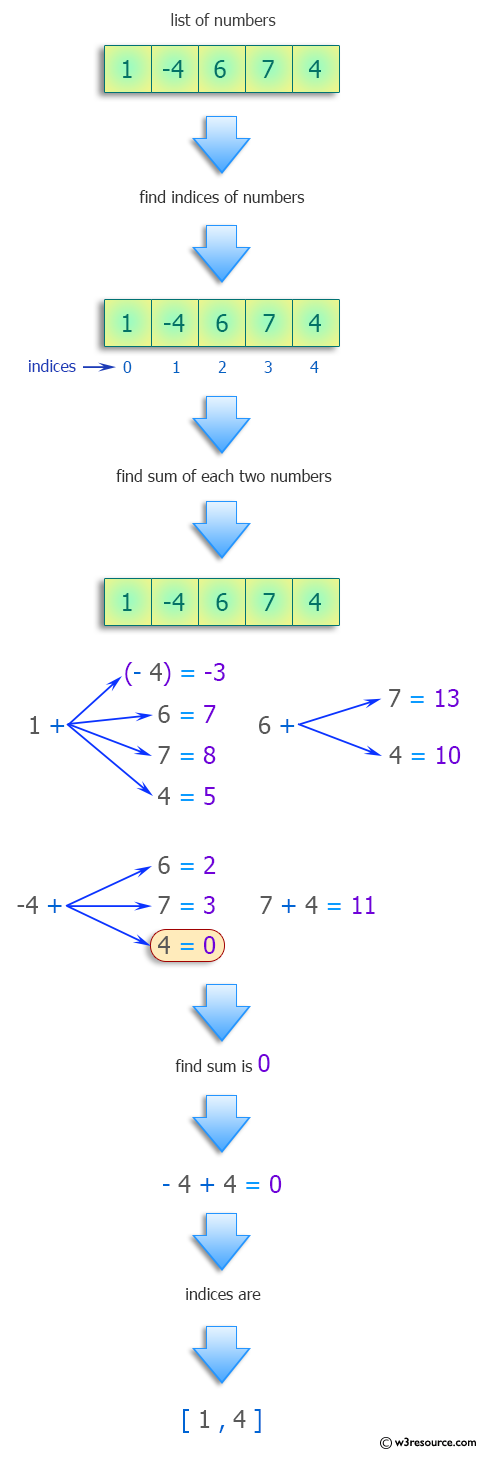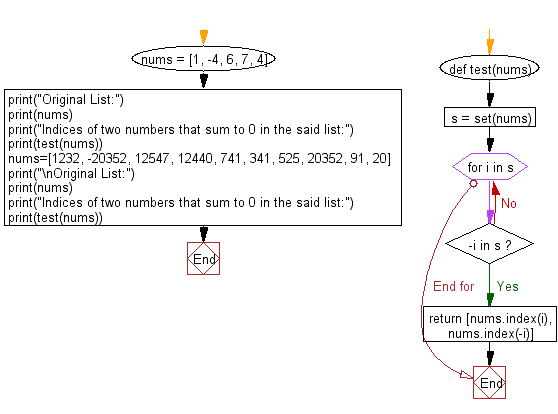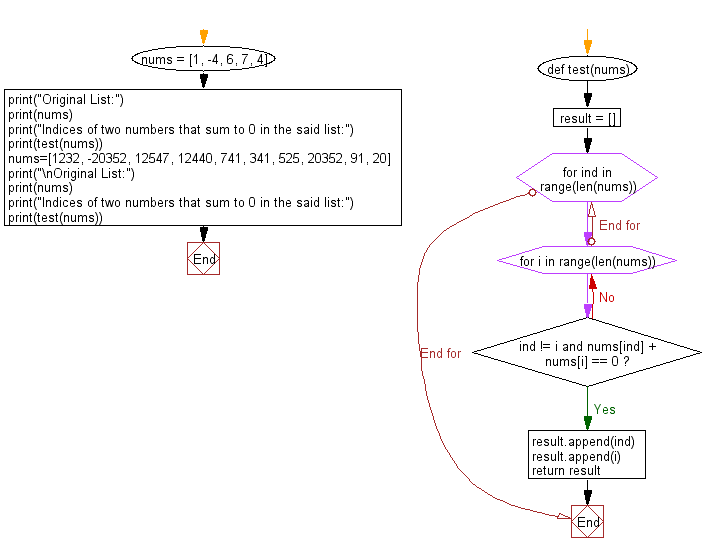Python: Find the indices of two numbers that sum to 0 in a given list
Python Programming Puzzles: Exercise-29 with Solution
Write a Python program to find the indices of two numbers that sum to 0 in a given list of numbers.
Input: [1, -4, 6, 7, 4] Output: [4, 1] Input: [1232, -20352, 12547, 12440, 741, 341, 525, 20352, 91, 20] Output: [1, 7]
Pictorial Presentation:

Sample Solution-1:
Python Code:
#License: https://bit.ly/3oLErEI
def test(nums):
s = set(nums)
for i in s:
if -i in s:
return [nums.index(i), nums.index(-i)]
nums = [1, -4, 6, 7, 4]
print("Original List:")
print(nums)
print("Indices of two numbers that sum to 0 in the said list:")
print(test(nums))
nums=[1232, -20352, 12547, 12440, 741, 341, 525, 20352, 91, 20]
print("\nOriginal List:")
print(nums)
print("Indices of two numbers that sum to 0 in the said list:")
print(test(nums))
Sample Output:
Original List: [1, -4, 6, 7, 4] Indices of two numbers that sum to 0 in the said list: [4, 1] Original List: [1232, -20352, 12547, 12440, 741, 341, 525, 20352, 91, 20] Indices of two numbers that sum to 0 in the said list: [1, 7]
Flowchart:

Visualize Python code execution:
The following tool visualize what the computer is doing step-by-step as it executes the said program:
Sample Solution-2:
Python Code:
#License: https://bit.ly/3oLErEI
def test(nums):
result = []
# For each index in the list:
for ind in range(len(nums)):
# For each index in the list:
for i in range(len(nums)):
# If the number at the current index and the other index sum to zero
if ind != i and nums[ind] + nums[i] == 0:
result.append(ind)
result.append(i)
# Found the indices; no need to go through the whole list
return result
nums = [1, -4, 6, 7, 4]
print("Original List:")
print(nums)
print("Indices of two numbers that sum to 0 in the said list:")
print(test(nums))
nums=[1232, -20352, 12547, 12440, 741, 341, 525, 20352, 91, 20]
print("\nOriginal List:")
print(nums)
print("Indices of two numbers that sum to 0 in the said list:")
print(test(nums))
Sample Output:
Original List: [1, -4, 6, 7, 4] Indices of two numbers that sum to 0 in the said list: [1, 4] Original List: [1232, -20352, 12547, 12440, 741, 341, 525, 20352, 91, 20] Indices of two numbers that sum to 0 in the said list: [1, 7]
Flowchart:

Visualize Python code execution:
The following tool visualize what the computer is doing step-by-step as it executes the said program:
Python Code Editor :
Have another way to solve this solution? Contribute your code (and comments) through Disqus.
Previous: Select a string from a given list of strings with the most unique characters.
Next: Find the list that has fewer total characters (including repetitions).
What is the difficulty level of this exercise?
Test your Programming skills with w3resource's quiz.
Python: Tips of the Day
Find current directory and file's directory:
To get the full path to the directory a Python file is contained in, write this in that file:
import os dir_path = os.path.dirname(os.path.realpath(__file__))
(Note that the incantation above won't work if you've already used os.chdir() to change your current working directory, since the value of the __file__ constant is relative to the current working directory and is not changed by an os.chdir() call.)
To get the current working directory use
import os cwd = os.getcwd()
Documentation references for the modules, constants and functions used above:
- The os and os.path modules.
- The __file__ constant
- os.path.realpath(path) (returns "the canonical path of the specified filename, eliminating any symbolic links encountered in the path")
- os.path.dirname(path) (returns "the directory name of pathname path")
- os.getcwd() (returns "a string representing the current working directory")
- os.chdir(path) ("change the current working directory to path")
Ref: https://bit.ly/3fy0R6m
- New Content published on w3resource:
- HTML-CSS Practical: Exercises, Practice, Solution
- Java Regular Expression: Exercises, Practice, Solution
- Scala Programming Exercises, Practice, Solution
- Python Itertools exercises
- Python Numpy exercises
- Python GeoPy Package exercises
- Python Pandas exercises
- Python nltk exercises
- Python BeautifulSoup exercises
- Form Template
- Composer - PHP Package Manager
- PHPUnit - PHP Testing
- Laravel - PHP Framework
- Angular - JavaScript Framework
- Vue - JavaScript Framework
- Jest - JavaScript Testing Framework
